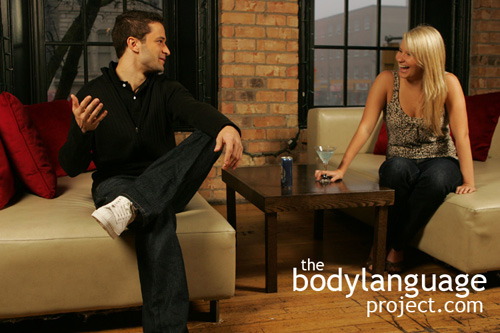
Pointing makes your message more poignant, but only because the receiver is being figuratively jabbed by your spear.
The pointer is akin to a spear thrower. Every time they thrust their finger forward it is as if they are jabbing their ideas into the kidneys of their audience. Alternately, the finger can be used rhythmically in an up and down motion seemingly beating down upon their opponent trying to create submission. The finger pointer makes his appearance during aggressive verbal fights where the accuser is making strong personal attacks against the other. Very negative emotions are attached to such actions so it’s best to avoid this gesturing. Finger pointing puts the reflection and responsibility onto the listener, and for this reason, they attach negative connotations to the speaker. It creates defensive feelings in the listener and as it persists these defensive feelings grow into aggression. Parents will often use the pointing finger to scold children but adults will be far less tolerant of other’s authority especially those of equal status so it is unwise to exercise this gesture with abandon. Even more pronounced than the finger spear is the hammer fist where the hand is made into a ball serving to repeatedly “hammer” the speech into the listeners. The hammer fist shows conviction and determination, where neither might be present. When the fingers are curled lightly not quite making a fist, the intent is to show mild power and a desire to be taken seriously but lacking the conviction found in the hammer fist.

The “politicians gesture” comes across less threatening, and is more suited to making a point to an audience.
An alternate, and abbreviated form of the pointing figure, is the thumb in hand gesture where the thumb lies against the index finger and where the remaining fingers form a ball. The hand then motions as if pointing, and in a rhythmic motion, emphasize points with conviction. The thumb in hand gestures is the “politicians gesture” since it is frequently used by various Presidents and world leaders. The thumb in hand gesture is much less offensive than the pointing finger, but can appear smug when done by those of lower status. Speakers might also use the “OK” gesture which is done by placing the thumb against the index finger forming an opening with the remaining fingers flared out.
The thumb in hand and the OK signal are considered to be more thought provoking and honest than finger pointing and takes the responsibility back from the listeners and places it back on the speech. The OK signal rotated so the fingers face the audience, with the thumb inward, is used when we want to show precision and delicacy. Without being careful with the OK gesture it can appear as uncertainty as is the case when the thumb and index finger come close, but don’t quite touch. In this case, the gesture is more useful when posing questions rather than making statements.
Additional gestures:
______________________________________________________________________________________________

It was this big!
[A] The measurer. The hands are moved parallel to one another and juggled up and down as if measuring an object. This signals a desire to project thoughts onto others.
______________________________________________________________________________________________

Accepting the audience.
[B] The finger spreader. The hands are held out and finger splayed apart facing palm to the audience. This is an attempt to make contact with the entire audience.
______________________________________________________________________________________________

The “offerer” wants to give you his thoughts and just doesn’t understand your point of view.
[C] The offered. The hands are palm up as if giving a gift. This is a beggar’s plea where agreement is desperately sought from the audience.
______________________________________________________________________________________________

Accept me as I accept you.
[D] The hugger. The arms are made into a circle in front of the body with the palms facing inward toward the speaker. The speaker wishes for the audience to accept his way of thinking or in other cases, the speaker is trying to grasp his own hypothesis.
______________________________________________________________________________________________
[E] The traffic cop. The hands are placed palm up in a stop motion. The speaker wishes the audience to settle or calm so they can continue.
______________________________________________________________________________________________
















